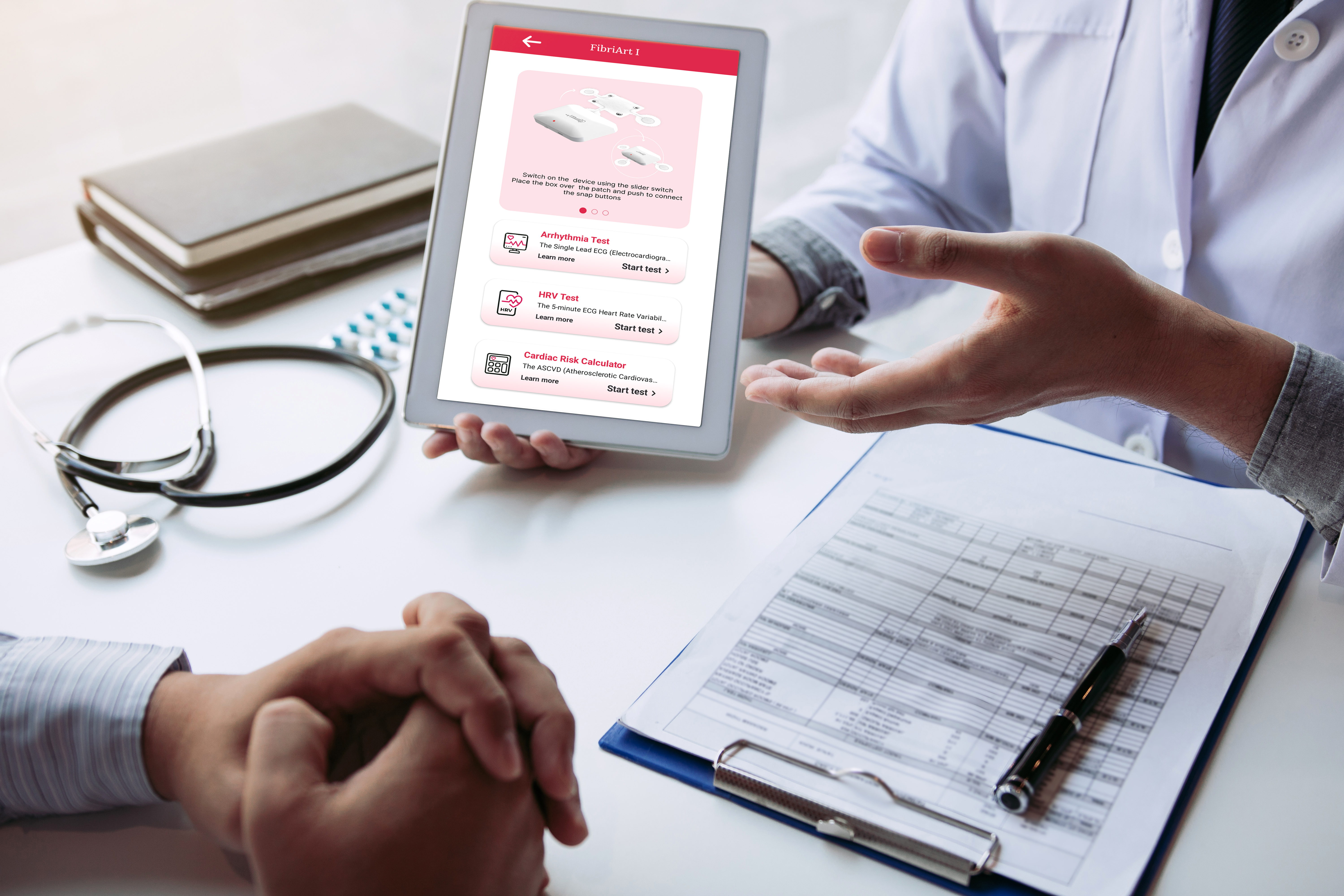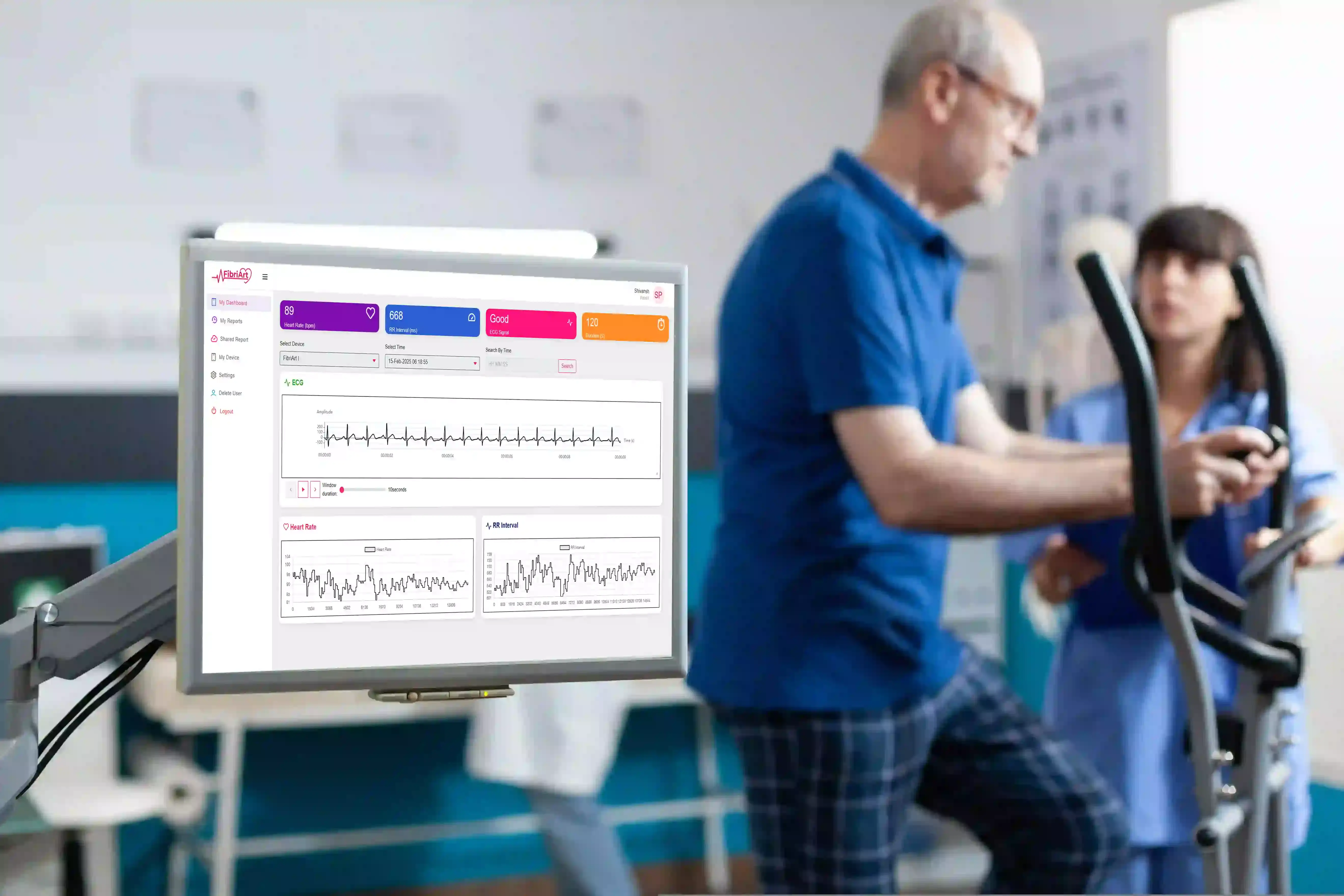The demand for real-time cardiac monitoring has led to a significant rise in the use of wearable ECG devices. These compact, non-invasive tools provide continuous heart rhythm monitoring, improving early detection and management of arrhythmias. However, with the rapid expansion of technology, consultant cardiologists must evaluate the clinical accuracy, reliability, and limitations of these devices before integrating them into patient care.
This article provides a clear and evidence-based overview of the clinical accuracy of wearable ECG devices, focusing on what cardiologists need to know, with insights into leading technologies like FibriArt.
The Rise of Wearable ECG Technology
Advances in mobile health have introduced a wide variety of wearable heart monitor patches, smart patches, and mobile cardiac telemetry monitors. Devices like FibriArt offer real-time data, wireless connectivity, and remote patient monitoring capabilities, aligning with the growing demand for home-based healthcare solutions.
FibriArt, in particular, provides highly accurate, comfortable, and discreet ECG patches suitable for continuous heart rhythm tracking, ideal for detecting arrhythmias and other cardiac events. Their mobile cardiac telemetry solutions are designed to support early intervention, clinical decision-making, and ongoing management of cardiovascular conditions.
How Accurate Are Wearable ECG Devices ?
Clinical accuracy in wearable ECG devices is evaluated based on:
- Sensitivity: The ability to detect true positives (e.g., arrhythmias).
- Specificity: The ability to rule out false positives.
- Signal Quality: Clear ECG waveforms without motion artifacts.
- Heart Rate Detection: Reliable heart rate data analysis and ECG counting heart rate across different conditions.
Recent studies show that high-quality wearable devices, such as FibriArt's products, can achieve over 90% sensitivity and specificity for common arrhythmias, including atrial fibrillation. FibriArt's ECG patches allow accurate calculation of heart rate from ECG, providing crucial data for clinicians without requiring bulky equipment.
However, device accuracy can be influenced by:
- Skin contact quality
- Body movement
- Electrode design
- Data transmission stability
Therefore, selecting clinically validated devices is critical.
Key Clinical Applications
Wearable ECG technology is now commonly used for:
- Arrhythmia detection: Identifying irregular rhythms via arrhythmia ECG or arrhythmia EKG.
- Remote patient monitoring: Tracking patients with known cardiovascular diseases or at risk of cardiac events.
- Post-operative monitoring: Early identification of complications after cardiac procedures.
- Medication management: Monitoring the effects of heart arrhythmia drugs on cardiac rhythm.
- Heart rate analysis: Supporting calculating heart rate in ECG for overall cardiovascular assessment.
With advanced devices like those offered by FibriArt, continuous ECG monitoring can support better diagnostic accuracy, particularly in outpatient settings.
Important Considerations for Cardiologists
Before recommending wearable ECG technology, cardiologists must assess:
- Validation studies: Devices should be supported by peer-reviewed clinical data.
- User compliance: Devices must be easy to wear and unobtrusive.
- Data security: Patient data must be encrypted and HIPAA-compliant.
- Integration capabilities: Compatibility with electronic health records (EHRs) and clinical workflows.
Additionally, it is essential to recognize that while wearable devices are excellent for rhythm monitoring, they are not yet a replacement for full diagnostic ECGs conducted in clinical settings.
FibriArt: A Reliable Partner in Cardiac Monitoring
FibriArt's solutions bridge the gap between continuous monitoring and clinical decision-making. FibriArt is lightweight, waterproof, and designed for remote patient monitoring programs. It delivers heart rate monitor readings, supports real-time alerts, and helps calculate heart rate from ECG efficiently.
Addressing Common Technical Queries
Calculating Heart Rate from ECG
Heart rate is determined by measuring the time between two successive R-waves (the sharp upward spikes) on the ECG trace. The formula is simple:
Heart Rate (bpm) = 60 / R-R interval (seconds).
Project Arrhythmia and Heart Monitoring
While "Project Arrhythmia" often refers to a game title, in a clinical context, arrhythmia projects focus on tracking and analyzing irregular heart rhythms using wearable monitoring solutions like FibriArt's devices.
Choosing a Smart Patch
A smart patch should offer accurate detection, long battery life, waterproofing, and reliable data transfer. FibriArt's smart patches meet these criteria and provide dependable monitoring even during everyday activities.
Understanding Heart Rhythm Problems
Arrhythmias occur when the electrical signals that coordinate the heartbeats are not working correctly, causing the heart to beat too fast, too slow, or irregularly.
Selecting a Cardiac Monitor
An Acardiaca monitor should have FDA clearance, excellent signal quality, and real-world validation studies demonstrating its performance for arrhythmia detection.
FAQs
1. Are wearable ECG patches as accurate as hospital-grade ECGs?
While hospital ECGs remain the gold standard, clinically validated wearable ECG patches, like those from FibriArt, offer high accuracy for arrhythmia detection and heart rate monitoring, especially when used for continuous, long-term observation.
2. Can wearable ECG devices detect all types of arrhythmias?
Wearable devices are highly effective at detecting common arrhythmias such as atrial fibrillation and bradycardia. However, some rare or complex arrhythmias may require additional evaluation with standard 12-lead ECGs or other diagnostic tools.
3. How long can patients wear a heart monitor patch?
Depending on the device, patients can wear heart monitor patches for several days to weeks. FibriArt's patches are designed for extended wear, offering durable adhesion and comfort without compromising data quality.
4. How do wearable heart monitors transmit data?
Wearable devices typically use Bluetooth or cellular networks to transmit ECG data securely to a cloud platform, where healthcare providers can review it in near real-time.
5. Is it safe for patients to shower while wearing an ECG patch?
Yes, many modern patches, including FibriArt's heart monitoring solutions, are waterproof, allowing patients to continue daily activities like showering without removing the device.
Enhance your practice with FibriArt's advanced ECG patches for reliable heart monitoring.
Discover FibriArt Solutions



